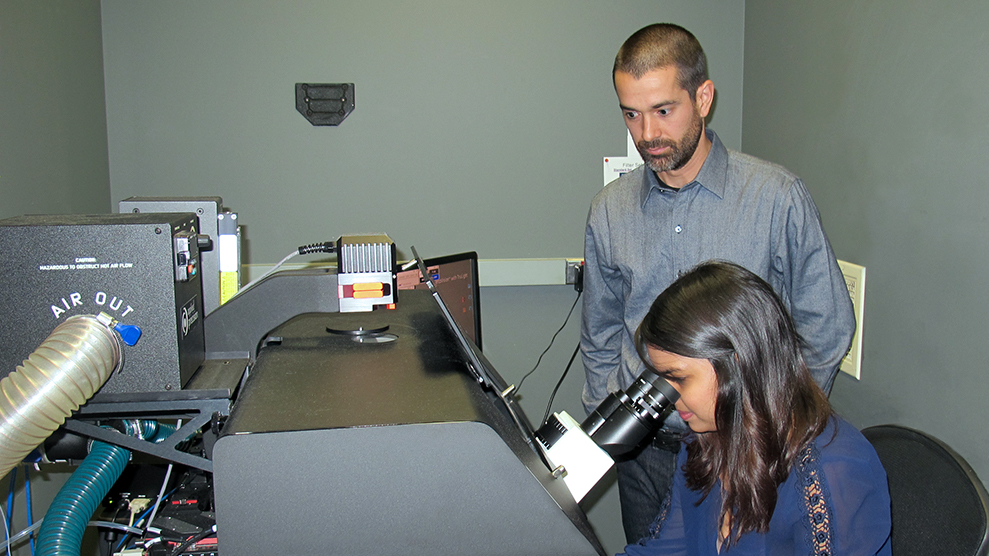
Ben Montpetit and Azra Lari examine how RNA travels from the cell's nucleus
Discovery science led by the University of Alberta's Faculty of Medicine & Dentistry is opening a window on cell biology rarely seen before. New research featured in the Journal of Cell Biology has revealed a real-time look at how genetic information travels within a living cell.
The discovery, observed through a specially designed high-powered microscope, significantly alters current understanding of how RNA is transported from a cell's nucleus-findings that researchers believe will lead to medical advances.
"You need to understand the system so that when it's broken, you know how to fix it," says Ben Montpetit, senior author of the study and an assistant professor in the Department of Cell Biology at the U of A. "I often use the analogy of a mechanic. If your car breaks down, you bring it to the mechanic because they understand how the car works, where to look and how to diagnose the issue. But if they didn't understand how the car works and, say, your car didn't start, would the mechanic spend an hour looking at the ashtray?"
"We really need to understand the system, and this technology is allowing us to do that now," adds Azra Lari, lead author of the study and a PhD candidate in the Department of Cell Biology.
Until now, scientists observing how RNA travelled from the nucleus would rely on a still image, giving them only a static snapshot of what was happening. New technology developed for the study allowed the research team to observe particles nanometres in size-a billionth of a metre-over just milliseconds in a living yeast cell. By recording the events, they observed the route and time taken for the RNA to be transported from the nucleus to the cytoplasm, where it is then used to encode proteins-the workhorses of the cell. They also observed how that changed after introducing a mutation into the system.
"With the old technology, we could tell there was a defect but could not tell where it was happening. Now we can see the errors occurring in real time," says Montpetit. "And already with this new imaging technique we're seeing defects that we didn't expect-that the models we have wouldn't have predicted. It just highlights how useful this new technology is going to be."
"Discovery research is really the driving force that leads to new innovation. It fuels new discovery and is the type of research that solves big problems."
The research team's work will continue on two fronts-pressing on with their efforts to study mutations and other factors that affect RNA transport, while also honing the imaging technology that made their groundbreaking research possible. They believe this innovative technology will soon help scientists gain an unprecedented understanding of the cell.
The research was the result of an international collaboration between labs at the U of A's Faculty of Medicine & Dentistry, the University of Massachusetts Medical School and the Swiss Federal Institute of Technology in Zürich. It was supported by grants from the Canadian Institutes of Health Research, Canada Research Chairs, Canada Foundation for Innovation, Alberta Research Capacity Program and an Alberta Innovates - Technology Futures Graduate Scholarship.